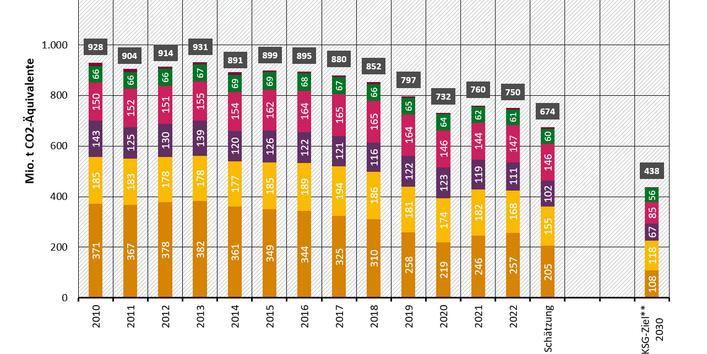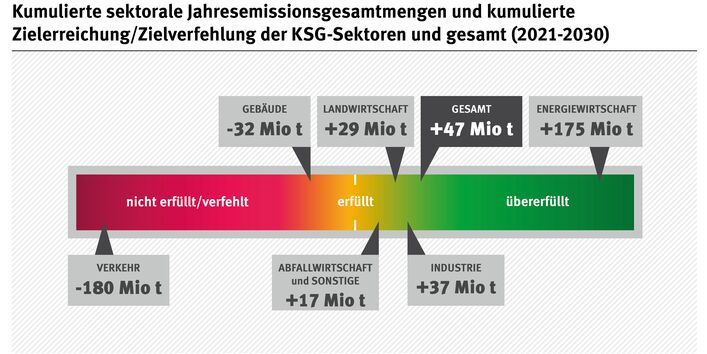Climate emissions fall by 10.1 per cent in 2023 – biggest decline since 1990
In 2023, greenhouse gas (GHG) emissions in Germany fell by 10.1 per cent compared to 2022. This is shown by new figures from the German Environment Agency (UBA). The reasons for this are the increased share of renewable energies, a decline in fossil fuel energy production and lower demand for energy from industry and consumers. In total, around 673 million tonnes of GHG were released in Germany in 2023 – 76 million tonnes or 10.1 percent less than in 2022. This is the sharpest decline since 1990. However, the transport sector in particular needs to take further action on climate protection. It is once again falling well short of its climate targets and is 13 million tonnes above the permitted sector budget.
UBA President Dirk Messner summarises the figures in this way: “With the outbreak of the war against Ukraine, many were worried that we would see a renaissance of coal and other fossil fuels. We now know that this has not happened. This is mainly due to the very successful expansion of renewable energies. This is a major step that will help us with climate protection in the coming years. But we are not doing so well in all sectors. The transport sector in particular remains a major cause for concern. We urgently need to do more in this area – for example, by expanding electromobility and reducing company car privileges and other climate-damaging subsidies. Looking ahead to 2030, I’m confident that we will be able to meet the national climate targets. We have already made great progress on climate protection. At the beginning of the legislative period, we were still forecasting a surplus of 1,100 million tonnes of GHG emissions for 2030. Now we can see in our projections for 2030 that this gap will be closed if we continue to work with the same level of ambition on climate protection.”
In the energy sector, GHG emissions in 2023 fell by around 51.8 million tonnes of CO₂ equivalents or 20.1 percent compared to the previous year, which is due to the reduced use of fossil fuels to generate electricity and heat. This decline was particularly strong in the use of brown coal and hard coal as well as natural gas. The reasons for this include the significant drop in coal-fired power generation, the consistent expansion of renewable energies and an electricity import surplus coupled with a simultaneous drop in energy demand. Other drivers were energy savings as a result of higher consumer prices and the mild weather conditions in the winter months.
In industry, emissions fell for the second year in a row to around 155 million tonnes of CO 2 equivalents in 2023. This represents a decrease of almost 13 million tonnes or 7.7 percent compared to the previous year. At around 18 million tonnes of CO2-equivalents, the industrial sector is thus below its annual emissions volume for 2023. Here, too, the decline in emissions is determined by the reduced use of fossil fuels, particularly natural gas and hard coal. Key drivers of this trend are the negative economic development and increased production costs, which have led to declines in production.
The building sector also achieved a reduction in emissions from 8.3 million tonnes of CO₂ equivalents to around 102 million tonnes of CO₂ equivalents (minus 7.5 percent). Despite this reduction, the building sector once again exceeded the annual emissions permitted under the Federal Climate Protection Act (KSG), this time by around 1.2 million tonnes of CO₂ equivalents. The main drivers for the decline in emissions are once again energy savings due to the mild weather conditions in the winter months of 2023 and higher consumer prices. The expansion of heat pumps also had a positive effect on the trend in emissions in the building sector, for example because less natural gas and heating oil were used.
The transport sector accounted for around 146 million tonnes of CO₂equivalents in 2023. This means that GHG emissions in the transport sector are around 1.8 million tonnes (1.2 percent) below the 2022 figure and around 13 million tonnes above the annual emission volume of 133 million tonnes of CO₂equivalents permitted under the KSG for 2023. Emissions had risen slightly in the previous year. In view of the fact that the building sector only slightly exceeded its target, transport is the only sector to fall well short of its target and move further away from the statutory target path. However, the main driver of the slight decrease in emissions is not effective climate protection measures, but the declining milage. in road freight transport. Compared to 2022, however, passenger car traffic increased slightly in 2023. The new electric vehicles registered in the passenger car segment last year have a slightly emission-reducing effect here.
Projection data for the year 2030:
The latest UBA projection data for 2024 published today clearly shows that, compared to the UBA projection report 2023, the new climate protection measures at national and European level can have an impact. With an ambitious expansion of renewable energies, the national climate targets remain achievable across all sectors by 2030. The cumulative total annual emissions even show an overachievement of 47 million tonnes of CO₂ equivalents across all sectors by 2030. Germany is therefore very close to achieving the target of reducing GHG emissions by 65 per cent by 2030 compared to 1990 with the measures currently planned.
Like the emissions data, the current projection data also shows that the climate protection efforts in the individual sectors are having varying degrees of success. For example, the transport sector has a cumulative reduction gap of 180 million tonnes of CO₂ equivalents by 2030. For example, the transport sector has a cumulative reduction gap of 32 million tonnes of CO₂equivalents by 2030. In contrast, the energy sector will exceed its emissions target by 175 million tonnes of CO₂equivalents, which is largely due to the successful expansion of renewable energies by 2030. According to projection data, the industry sector will also exceed its statutory targets by 37 million tonnes of CO₂ equivalents, with the recovery of industry going hand in hand with its decarbonisation in the coming years. The agriculture, waste management and other sectors exceed their targets by 29 million tonnes and 17 million tonnes of₂ equivalents respectively.
Further information:
The available emissions data for 2023 represent the best possible calculation at present. They are associated with corresponding uncertainties, in particular due to the limited statistical basis for calculation available at this time. The calculations are derived from a system of model calculations and trend extrapolations of the detailed inventories of GHG emissions for 2022 published in January 2024. The complete, official and detailed inventory data on GHG emissions in Germany for 2023 will be published by the UBA in January 2025 with the submission to the European Commission.
To prepare the projection data and the Federal Government's projection report, the UBA regularly commissions an independent research consortium that uses an integrated modelling approach to estimate the impact of current climate protection policy on Germany's climate-damaging greenhouse gas emissions. The focus is on the results in the sectors up to the year 2030 and in the year 2045. The UBA is coordinating the work in close consultation with the responsible ministries in all sectors at federal level (energy, transport, industry, buildings, waste management, agriculture and land use, land use change and forestry).
These projections should not be misunderstood as forecasts for coming years. For projections, models are used that project a long-term, plausible greenhouse gas emissions trend under the conditions and assumptions at the time the modelling was started. Special effects that occur and unforeseen, short-term events, such as the energy crisis last year, cannot be integrated methodically, or only to a limited extent.
In addition to the short paper "Greenhouse gas projections 2024 – Compact results" published today on the projection data for 2024, the UBA published the assumptions for calculating the greenhouse gas projections at the beginning of March 2024:
Greenhouse gas projections 2024 for Germany – Instruments (German)
Greenhouse gas projections 2024 for Germany – Framework data (German)





